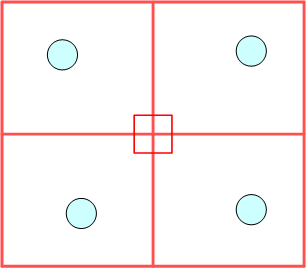Russian four square facts for kids

A schematic layout of Russian four square.
|
|
| Nicknames | Russian Foursquare, RFS |
|---|---|
| First played | Mid-20th century Soviet Russia |
| Characteristics | |
| Contact | yes |
| Team members | none, players fly solo |
| Mixed-sex | Yes, separate competitions |
| Type | amateur sports, ball sport |
| Equipment | Soccer ball, or volleyball |
Russian four square is an exciting outdoor game that started in the Soviet Union. It's a fun twist on a traditional Russian game called "Kvadrat," which means "square." You play it on a court divided into four squares, and the goal is to become the "King" or "Czar" of the game!
Contents
Playing Russian Four Square
What You Need to Play
To enjoy a game of Russian four square, you will need a few things:
- A ball, like a soccer ball or volleyball.
- Four or more players.
- A flat playing area.
- This area needs to be divided into four equal squares.
The Goal of the Game
Every player starts the game with 5 points. Your main goal is to reach the "King's square" and stay there. When you are in the King's square, you become the "Czar" or "dictator" of the game. Your job is to try and get other players out of their squares!
Player Positions on the Court
Each of the four squares on the court has a special name and position:
- 1st Square: This is the Peasant's square.
- 2nd Square: This is the Duke's square.
- 3rd Square: This is the Prince's square.
- 4th Square: This is the King's square.
How to Play: The Rules
Starting the Game
The player in the "Peasant's square" starts the game. They serve the ball diagonally into the middle square using their hands. After that, the "Duke" hits the ball into another player's square. Now the game has officially begun!
Understanding Penalty Points
Players lose points for certain mistakes. The number of points you lose depends on how the mistake happened. Here's how penalty points are counted:
- If you hit the ball into someone's square, and they miss it, the points they lose depend on what body part you used:
- Hitting with your knee: 2 points.
- Hitting with your head: 3 points.
- Hitting with both knees: 4 points.
- Hitting the ball into the solid middle square: 5 points.
- Any other way of hitting the ball: 1 point.
- You also get penalty points if:
- You touch the ball with your arm or hand, except when serving.
- The ball bounces twice in your square.
- You cause the ball to bounce twice in the "no-mans-land" (the area around the squares).
- You hit the ball after it has already bounced in someone else's square (this is called "playing someone else's square").
- You cause the ball to land directly in the very middle solid square. This means you automatically lose all five of your points! However, at least two other players must agree that this happened.
- If the ball hits your arm below the shoulder at any time, you automatically lose one point. For example, if someone hits the ball into your square for 3 points, and you catch it or hit it with your hand, you lose 3 points instead of just 1.
- When a player loses all five of their points, they are out of that round. They must go to the end of the line of players waiting to join. If there's no line, they go back to the 1st square.
The Score Keeper's Role
The next person waiting to play can be the score keeper. They might use small rocks to keep track of points, placing them in a miniature square that matches the player's position on the court. This score keeper can be called the "keeper of the stones" or simply the "stoner." No one is allowed to argue with the stoner's decision. The stoner has the highest authority, but if two or more other players agree, they can overrule the stoner.
How to Win
The game continues until at least one player reaches a score of 20 points. At that moment, the game ends. The player who has the fewest points at that time is declared the winner!

